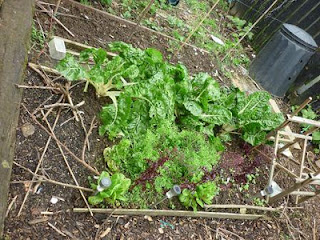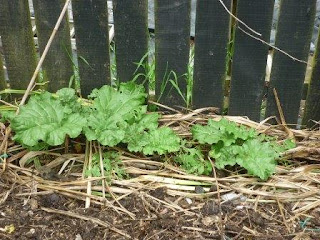View over garden beds planted with silverbeet, garlic, mesclun, coriander, cucumber, courgette, lettuce, spring onion, and calendula.
The garlic bed: 30 bulbs to be harvested in January (at $1.32 each for NZ garlic). I will then put it into parsnip for a winter crop.
One of our espaliered apples - all you need is a spare fence to grow apples, pears, peaches, quinces, figs, or grapes. Its not difficult (more a case of tough love for bending and pruning them into shape) and I love the look.
Our silverbeet grows massive and lush, but I think it is the copious compost and liquid fertiliser it gets that makes this difference.
Our courgette bed (shortly I will pull out the weaker of each pair). To maximise production I interplant with quick-to-harvest plants like mesclun and pak choi (these are the seedlings you can see germinating everywhere). These will grow to maturity and be harvested before the courgettes engulf the bed for the remainder of the summer. When the courgettes finish in April-May, this bed will become our winter salads bed for 2012.
Our current salad bed, with carrots (left end), lettuce, mizuna, cress, cornsalad (centre) and radish and cucumber (right hand end).
Recently divided rhubarb with compost added to the bed and a thick mulch of flax leaves to retain summer moisture. The bed was first planted 5 years ago, so was due for renewal. I expect to resume harvest of rhubarb in the New Year, and it will then keep on producing for a few more years.
Heavily composted bed. It might look rough but this is the kind of coarse organic matter that is sometimes needed to inject life into a compacted humus-poor soil. In a few weeks time this will be planted with Thai eggplants.








No comments:
Post a Comment